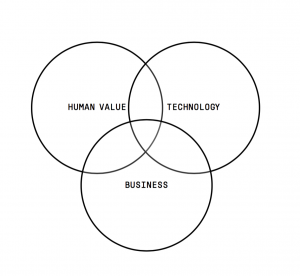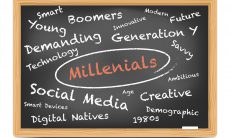Mapping was always something really fascinating to me. The ability to describe something, to project it right, to make the reader understand the perspective, and of course to have the right amount of information able to drive the person responsible for navigation and to set up the right route without overloading him with details was, and still is, something remarkable.
Nowadays, when we want to go from point A to point B thanks to Google or Apple, we choose in real time the route, the stops, and the area we drive through. We can even avoid traffic or report incidents in real time (using Waze). Any action may influence the decision making process of other drivers in the area. Therefore, nothing is linear and nothing is static. I remember twenty years ago, in order to travel you needed a map, a route, and the right signs. You had to follow them and double check them in order to not miss the destination, the turn, the right path. The results were reaching the destination but to miss, most of the time, hidden places, local gems, or points a map didn’t know that you might like or want to see.
Nowadays, we just point a destination and let the context drive the rest. We don’t need personalized recommendations, but something able to address our needs at the right context. Understanding the customer journey is becoming increasingly important as the number of both digital and offline touch points increases. In fact, people ask for something frictionless, where physical and digital experience becomes one.
Consumers base their decisions on interactions across multiple media types, devices and locations. This creates a challenge for marketers and brands to interact at important moments that might influence buying decisions. Therefore, we shift the conversation and the mapping from moments to understanding the flow, the synapses people make with others, the environment, and the things they touch and they change. Things become so fluid that we can’t predict, but we can make sure that we are part of something fluid.
At the same time, more and more devices get connected. We gather more data, we apply more intelligence to understand the clicks, the visits, the interactions people have with our brands, our website, what they look for while online, or what they need in order to make a decision while in a store, or while riding the bus to get to an event.
Beth Dean from Facebook wrote that “In the early aughts we learned to build websites without tables, then we learned to use data to make decisions. Emotion never played a role in driving page views, purchases, or video plays. We just needed to get people from point A to point B. People live their entire lives online now, we’re embarking on a new frontier as designers; we’re designing frameworks for people to exist online — a lot like they do offline.”
Now, emotional intelligence becomes more critical than ever to understand people, their needs, to address them, to map the context around them. Like in real life, knowing what happens among people is no longer enough, you need to know how to handle this intelligence.
Until recently, everything in the physical world was designed and implemented exactly the same way as 30 years ago. Made by engineers who were able to talk to machines, to “speak and write” their language: to code and deliver something other machines would be able to understand, interpret and get back with something engineers were able to do something with it. Therefore it was easy to map journeys, decisions, and understand somehow the “why’s.”
But we don’t stop being human when we go online, we don’t stop feeling, reacting, being influenced, asking others, feeling insecure, making mistakes, or acting by instinct and not by the book.
As Beth Dean says, “for years designers have approached software as though it were neutral: here’s a set of options, now complete a task. In reality, people interact with software like it’s a human. As designers, we can shift our approach to thinking about how people might feel using our products much like we would think about having a conversation with another person. The ability to handle relationships and be aware of emotions is called emotional intelligence, and it’s what’s often missing in software design today.”
We need a more human approach to everything; something able to learn, to adjust, to take advantage of the context, to be smart, but also to have emotional intelligence.
Our design-led approach needs to be characterized and based on what characteristics measures the emotional intelligence. These are:
- Self awareness
- Self regulation
- Motivation
- Empathy
- People skills
Nowadays, we need to add these layers to be applied to everything we design or that gets connected to the web. Products, services, and ecosystems have to be involved with something closer to what our behavior is. This can be achieved only if we start applying all the learning we gather from things we have designed.
Today, everything we do, or we decide to do, is based on our ability to build relationships with whom or what is around us. Emotions and facts drive us to understand, ask, demand, empathize, give space, ask for more, and compromise. In this context, nothing is neutral anymore. Everything has something to add, energy to contribute, or emotions to foster.
Some years ago, the neutrality of software allowed us to understand every possible logical outcome in a situation (though often we don’t), but we were unable to assign values to those outcomes. “This is especially true with binary systems: a person completes a task or they don’t. This sounds neutral, when in fact the consequences of not completing the task could range from inconvenient to devastating. This lack of awareness is where we get into trouble and sometimes unintentionally do harm. Reason without feeling is blind,” Beth Dean says. I would add that data, analysis, and an outcome without a reason or mission is like an empty shiny box: useless.
A clearly defined mission works like a compass to the outcome we want, but instead of having a Boolean approach, where everything is one or zero, we use a fuzzier one, able to drive people’s motivation to follow the path we have designed, or that allows them to understand the routes they take while doing, buying, or using something. In order to do so we need to chart people’s skills. This is an uncharted territory. As I said, in the past, everything was about machines’ skills. We mapped them well. Now, we need to understand people’s skills and how these react and adjust to our design-led approach.
At the end of the day, we have to try design and deliver a flow, a journey, or a product that is not dismissive of what people want and their needs. Everything is based on the relationships we build and how these are taking under consideration how mature things are. Understanding and mapping consumers’ journey is like nurturing a relationship, therefore we need to give everything, and invest on understanding how emotional intelligence can affect them without expecting anything in return.









